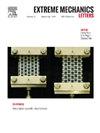Data-driven scheme for two-scale chemo-mechanical coupled problem for heterogeneous materials under transient chemical diffusion
IF 4.3
3区 工程技术
Q2 MATERIALS SCIENCE, MULTIDISCIPLINARY
引用次数: 0
Abstract
This study developed a data-driven computational scheme of multiscale multiphysics coupled problem for heterogeneous materials under transient chemical diffusion. Firstly, the data-driven scheme decouples the multiscale problem into two stages, i.e., offline generation of material constitutive behavior database by microscopic simulation, and online macroscopic boundary value problem (BVP) based on the data-driven mechanical scheme. In addition, data-driven scheme converts the multiphysics coupled constitutive relationship into the material conjugate quantities in database which avoids the poor convergence in multiscale multiphysics coupled calculation. Then, a two-scale chemo-mechanical model with a simple microstructure is validated in two cases: diffusion-induced mechanical deformation and deformation-enhanced chemical diffusion. The results show that the proposed framework can characterize the chemo-mechanical coupled behavior with good convergence and accuracy, which is more efficient than the full-scale finite element simulation. Finally, this data-driven scheme is applied to analyze the multilayer porosity structures for lithium-ion battery cathodes. The results show that cathodes with gradient porosity design can improve the utilization of active materials and enhance the effective capacity.
非均质材料瞬态化学扩散双尺度化学-力学耦合问题的数据驱动格式
本文提出了非均质材料瞬态化学扩散下多尺度多物理场耦合问题的数据驱动计算方案。首先,数据驱动方案将多尺度问题解耦为两个阶段,即通过微观模拟离线生成材料本构行为数据库,以及基于数据驱动力学方案的在线宏观边值问题。此外,数据驱动方案将多物理场耦合本构关系转换为数据库中的材料共轭量,避免了多尺度多物理场耦合计算收敛性差的问题。然后,在扩散引起的机械变形和变形增强的化学扩散两种情况下,验证了具有简单微观结构的双尺度化学-力学模型。结果表明,该框架能较好地表征化学-力学耦合行为,具有较好的收敛性和精度,比全尺寸有限元模拟更有效。最后,将该数据驱动方案应用于锂离子电池阴极的多层孔隙结构分析。结果表明,采用梯度孔隙度设计的阴极可以提高活性物质的利用率,提高阴极的有效容量。
本文章由计算机程序翻译,如有差异,请以英文原文为准。
求助全文
约1分钟内获得全文
求助全文
来源期刊

Extreme Mechanics Letters
Engineering-Mechanics of Materials
CiteScore
9.20
自引率
4.30%
发文量
179
审稿时长
45 days
期刊介绍:
Extreme Mechanics Letters (EML) enables rapid communication of research that highlights the role of mechanics in multi-disciplinary areas across materials science, physics, chemistry, biology, medicine and engineering. Emphasis is on the impact, depth and originality of new concepts, methods and observations at the forefront of applied sciences.
 求助内容:
求助内容: 应助结果提醒方式:
应助结果提醒方式:


